Instead, it has been preserved in the best freezer there is: the Oort Cloud, a huge region surrounding the Sun like a giant, thick soap bubble. It is estimated that it contains trillions of tiny icy bodies.
C/2014 S3 (PANSTARRS) was originally identified by the Pan-STARRS1 telescope as a weakly active comet a little over twice as far from the Sun as the Earth. Its current long orbital period (around 860 years) suggests that its source is in the Oort Cloud, and it was nudged comparatively recently into an orbit that brings it closer to the Sun.

Observations with ESO’s Very Large Telescope, and the Canada France Hawai`i Telescope, show that C/2014 S3 (PANSTARRS) is the first object to be discovered that is on a long-period cometary orbit, but that has the characteristics of a pristine inner Solar System asteroid. It may provide important clues about how the Solar System formed. This diagram shows the probable history of this object in both the inner and outer Solar System over a period of more than four billion years.The majority of this time was spent in the cold outskirts, in the Oort Cloud. Credit: ESO/L. Calçada
The team immediately noticed that C/2014 S3 (PANSTARRS) was unusual, as it does not have the characteristic tail that most long-period comets have when they approach so close to the Sun. As a result, it has been dubbed a Manx comet, after the tailless cat. Within weeks of its discovery, the team obtained spectra of the very faint object with ESO’s Very Large Telescope in Chile.
Careful study of the light reflected by C/2014 S3 (PANSTARRS) indicates that it is typical of asteroids known as S-type, which are usually found in the inner asteroid main belt. It does not look like a typical comet, which are believed to form in the outer Solar System and are icy, rather than rocky. It appears that the material has undergone very little processing, indicating that it has been deep frozen for a very long time.
The very weak comet-like activity associated with C/2014 S3 (PANSTARRS), which is consistent with the sublimation of water ice, is about a million times lower than active long-period comets at a similar distance from the Sun.
The authors conclude that this object is probably made of fresh inner Solar System material that has been stored in the Oort Cloud and is now making its way back into the inner Solar System.
A number of theoretical models are able to reproduce much of the structure we see in the Solar System. An important difference between these models is what they predict about the objects that make up the Oort Cloud.
Different models predict significantly different ratios of icy to rocky objects. This first discovery of a rocky object from the Oort Cloud is therefore an important test of the different predictions of the models. The authors estimate that observations of 50–100 of these Manx comets are needed to distinguish between the current models, opening up another rich vein in the study of the origins of the Solar System.





Comments